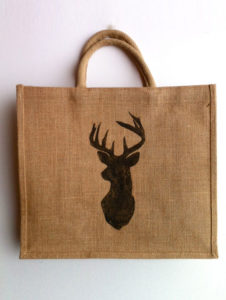Uses of Jute
Jute is known as the versatile fibre of nature because of its varying uses. During the Industrial Revolution, jute yarn simply replaced flax and hemp fibres, which were used to make sackcloth. Sacking makes up the bulk of manufactured jute products even to this day. One of the best key features of jute is its ability to be used either independently or to be blended with a large range of other fibres and materials. It is true that jute is being replaced by synthetic materials in many products, however jute bags manufacturers & jute bags suppliers take advantage of jute’s biodegradable nature, as synthetics would be unsuitable in such a case. Examples of such uses are in the form of containers for planting young trees, geotextiles for soil and erosion control where the application is simply designed to break down after sometime with no requirement for removing it.

Promotional Jute Bag
Advantages of jute fibres are good insulating and antistatic properties. Other advantages include low thermal conductivity and moderate retention of moisture.
Textiles
The most common products manufactured from jute fibre are: sacking, yarn and twine, hessian cloth, carpet backing cloth, hessian bags, and as well as for other textile blends. It’s high tensile strength & low extensibility. This ensures better breathability of fabrics. The jute fibres are woven into curtains, carpets, chair coverings and area jute rugs. The jute fibre is often blended with other fibres. These are both synthetic and natural. The finest threads are separated out and imitation silk is made from it. Jute can even be blended with wool. Jute treated with caustic soda, becomes crimp, soft, pliable, with improved appearance. It aides in its ability to be spun with the wool.
Packaging
Jute is usually used for sacking of agriculture goods. It is being used largely in rigid packaging, as well as, reinforced plastic. It is gradually replacing wood in pulp, as well as, paper.
By-products
Diversified by-products from this versatile fibre include its use in the fields of cosmetics, medicine, paints, etc. Jute sticks are commonly used as fuelling, as well as, fencing materials in the rural areas in the jute producing countries of South Asia. These are excellent substitutes for forest wood and bamboo especially for the production of particle boards, pulp and paper.
Producers
About 95% of world jute is grown in the two south Asian countries of India & Bangladesh, as well as, Nepal and Myanmar also produces some jute. Pakistan imports a substantial amount of raw jute, mainly from Bangladesh, for processing & manufacturing purpose. One of the eminent jute bags manufacturers of jute promotional bags & jute products suppliers, Sara International is an example of how local jute bags exporters take advantage of this booming industry.